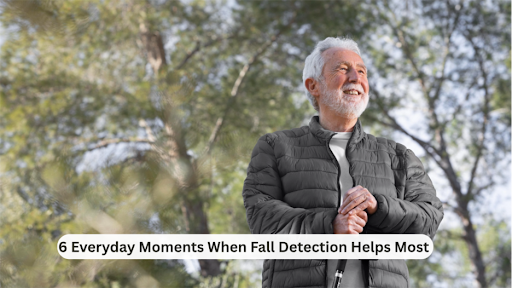Falls rank among the most prevalent causes that make people, specifically elderly and individuals with pre-existing medical conditions, seek hospitalization. According to the CDC, 1 in 4 older adults falls every year.
Speaking of which, a fall may alter the life of a person—it may lead to a broken bone, a brain injury, or the loss of independence. Enter modern fall detection technology.
In comparison to the traditional emergency buttons that require pressing, devices that automatically detect falls and call the emergency services are available. It can also get in touch with the family members regardless of whether or not the person can make the call.
Most people only consider fall detection in extreme situations, but it is the ordinary, everyday moments where it subtly saves lives. Below are six typical scenarios in which fall detection can prove to be more than handy; it is lifesaving and reassuring with the right implementation.
1. In the Bathroom: Slippery Floors and Lack of Support
The bathroom is among the riskiest areas of a home, particularly for seniors. That is because a wet floor and slippery tiles, as well as the necessity to move around bathtubs or showers, expose them to a high risk of falls. Even holding onto towel racks or loose fixtures may cause slips.
Bathroom falls are even more alarming since people are usually alone, and the small area may complicate self-help. Additionally, falls in wet places enhance the risk of head injuries and fractures from hard surfaces.
To prevent this, fall detection devices and, more specifically, water-resistant versions help put the necessary safety net in such situations. These devices make sure that someone will be called to help right away, even when the person cannot reach a telephone or make a call.
2. Nighttime House Walks
Most falls occur at night as people wake up and move about in the darkened rooms or unfamiliar areas. Even a short walk can be dangerous due to the poor lighting conditions, being tired, or having a medication reaction that may affect balance and reaction time.
Such night movements are common occurrences but can be dangerous to individuals with mobility problems. During these quiet hours, falls are frequently missed and result in a delay in seeking medical assistance.
However, with a fall detection device worn to bed, if a fall occurs overnight, an automatic alarm goes off instantly, alerting the nearest medical centers and getting help quickly to prevent any serious complications.
3. Doing Household Chores
Daily activities around the home, for example, mopping, vacuuming, or picking up something off a high shelf, involve bending, stretching, and moving around furniture. Such movements may easily cause a loss of balance, particularly to someone with a condition like arthritis, neuropathy, or vertigo.
This routine is carried out regularly and alone, contributing to increased risk factors. Moreover, falling with something in your hands can cause serious injuries, and sometimes the person who falls can even become unconscious.
Therefore, these are the most common activities that should be monitored by fall detection to trigger an alarm when an unexpected impact is noted.
4. Outside in the Garden or Yard

Light yard work or gardening is pleasant, albeit with certain inherent hazards. For example, unsteady surfaces, unexpected holes, broken rocks, or slippery grass can lead to accidental falls.
These falls are particularly dangerous as they can occur without being seen or heard by anyone inside the household. Also, outdoor falls may subject the victim to harsh weather conditions, such as cold exposure or heat exhaustion, if they are not rescued immediately.
In these cases, a fall detector that has GPS tracking is invaluable, because in addition to alerting the emergency contacts, it can also share their location within a few meters, allowing timely help to arrive.
5. During Solo Walking or Exercise

Walking or stretching is an important health tool for seniors and people with medical conditions. But balance problems, muscle fatigue, or unexpected health issues such as a dizzy spell or cardiac knock can make a stroll a hazard.
Such falls outside or in less populated regions are of grave danger since helpers are not always readily available. In other words, when a fall occurs, solo exercise may soon turn into a medical emergency because of delayed intervention.
However, the use of a fall detection device during such activities will provide assurance in case a fall happens. The alert system will report to an emergency response team despite the wearer being unconscious.
6. When Having Medical Episodes
Specific medical conditions, including epilepsy, diabetes, heart arrhythmias, or low blood pressure, can cause sudden loss of consciousness, seizures, or severe dizziness. When this happens, the injured individual might not be in a position to seek assistance following a fall.
These are life-or-death scenarios where time is of the essence. For instance, slow reaction may result in exacerbation of injuries, prolonged lying on the floor, or serious medical issues.
To prevent this, fall detection systems are designed to identify sudden motions and shocks associated with medical emergencies. Then, they send an alert to caregivers or the emergency response immediately.
Read More. Wellness Advice WutawHealth: Your Trusted Guide to Better Living
Conclusion
Falls can happen in the blink of an eye, often during life’s most routine moments. However, fall detection technology transforms these quiet risks into opportunities for immediate intervention, offering peace of mind for individuals and their loved ones.
Whether indoors or out, during daily tasks, unforeseen medical episodes and so on, having a smart safety net ensures help is never far away.
Thus, with fall detection, you’re not just reacting to accidents—you’re proactively safeguarding independence, health, and the freedom to move confidently each day.



